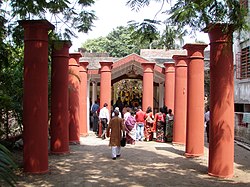Sabarna Roy Choudhury
The Sabarna Ray Chaudhurys (Bengali: সাবর্ণ রায় চৌধুরী) were Zamindars near Kolkata (earlier known as Calcutta), prior to arrival of the British.
Zamindari[edit]
The three villages of Sutanuti, Govindapur and Dihi Kalikata comprised a part of the jagirdari of Ray Chaudhury family — those territories were still owned by the Mughal emperor but the right to governance (and tax-collection, a major part of which was to be remitted to the Mughal Court) was granted to the Chaudhurys.[1][2] Sutanuti was a major wool-trading center during those times.[1]
On 9 November 1698, Prince Azim-ush-Shan (then-Viceroy of Bengal Subah) had a bainama (sale/transfer-deed) issued, conferring this jagirdari right on the East India Company; the Chaudhurys sold their rights to Charles Eyre for a sum of 1300 Rupees.[1][2][3]
Museum[edit]
Sabarna Sangrahashala (Bengali: সাবর্ণ সংগ্রহশালা) in Kolkata is run by the family.[4][5]
See also[edit]
References[edit]
- ↑ 1.0 1.1 1.2 Banka, Neha (25 August 2021). "Explained: 'Calcutta does not have a birthday', but it has some markers of urbanisation". The Indian Express.
{{cite web}}: CS1 maint: url-status (link) - ↑ 2.0 2.1 Nair, P. Thankappan, The Growth and Development of Old Calcutta, in Calcutta, the Living City, Vol I, p. 11, edited by Sukanta Chaudhuri, Oxford University Press, ISBN 0-19-563696-1
- ↑ Bhattacharyya, Debjani (2014). "Geography's myth: The many origins of Calcutta". In Pandey, Gyanendra (ed.). Unarchived Histories: The ‘mad’ and the ‘trifling’ in the colonial and postcolonial world. Abingdon: Routledge. pp. 148, 157. ISBN 9780415717755.
- ↑ "Sabarna Sangrahashala". Museums of India. sahapedia.org. Retrieved 25 August 2021.
- ↑ "ইতিহাস ও ঐতিহ্যের ধারক সাবর্ণ সংগ্রহশালা | বাংলাদেশ প্রতিদিন". Bangladesh Pratidin. 14 February 2015. Retrieved 25 August 2021.

